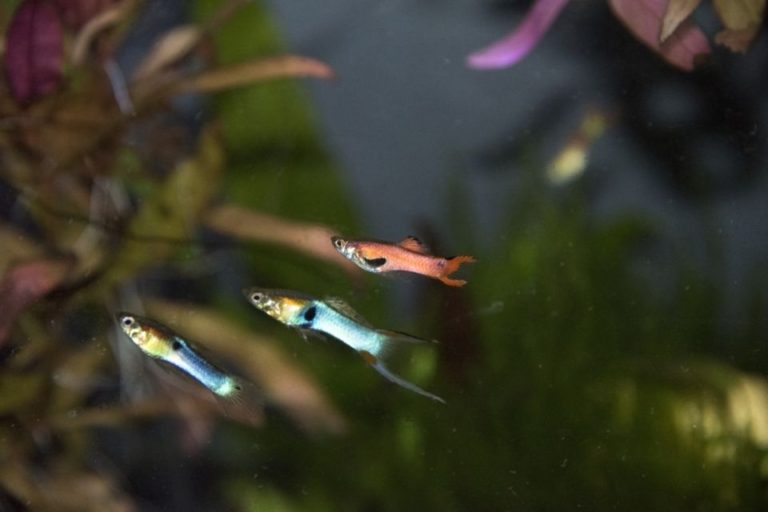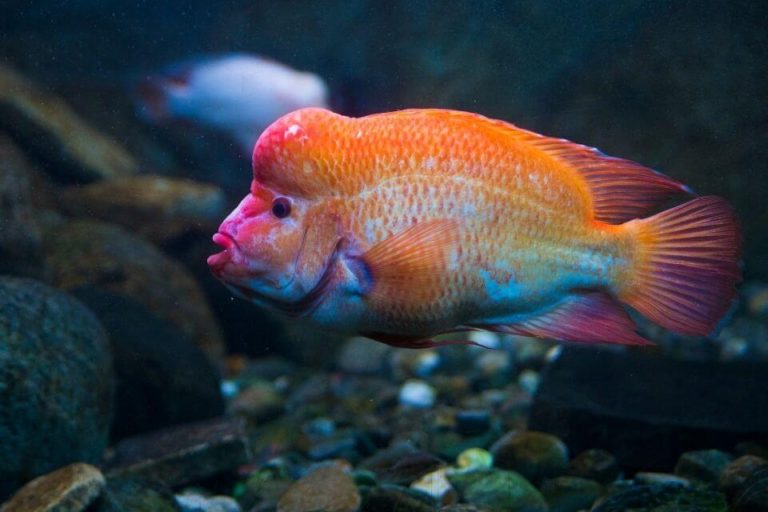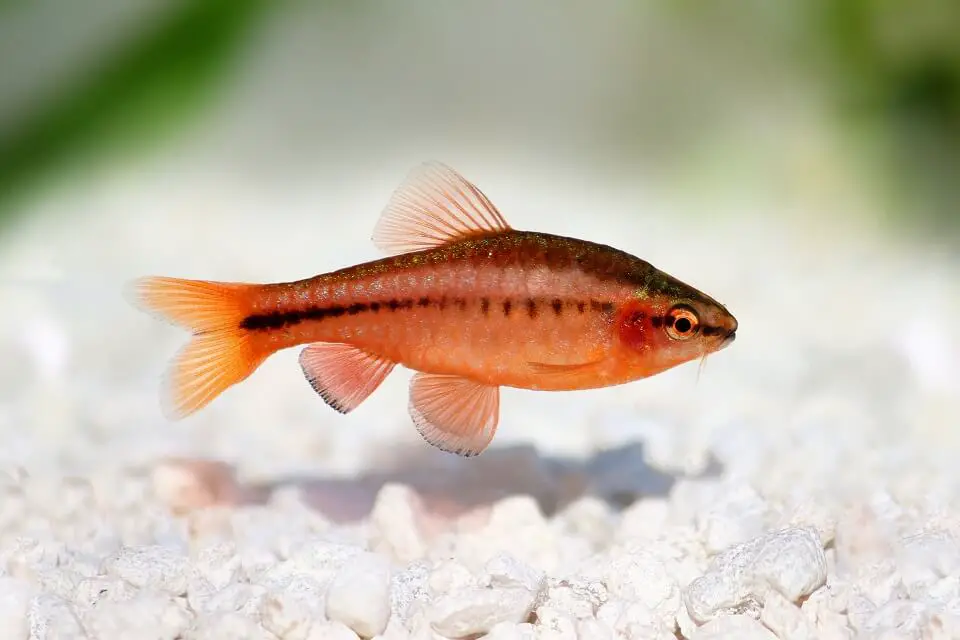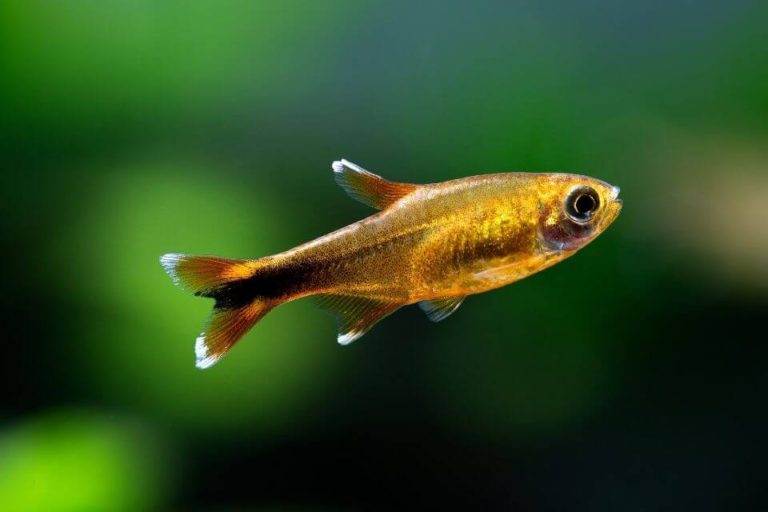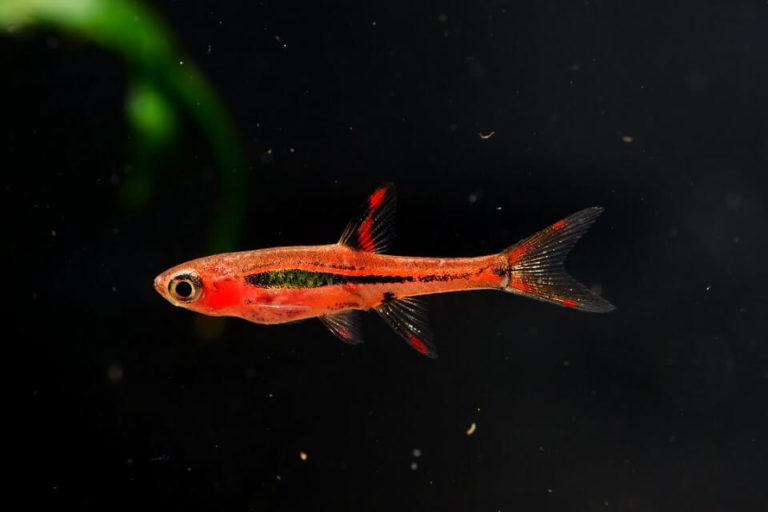The Complete Guide To Black Neon Tetra Care – Feeding and Tank Mates
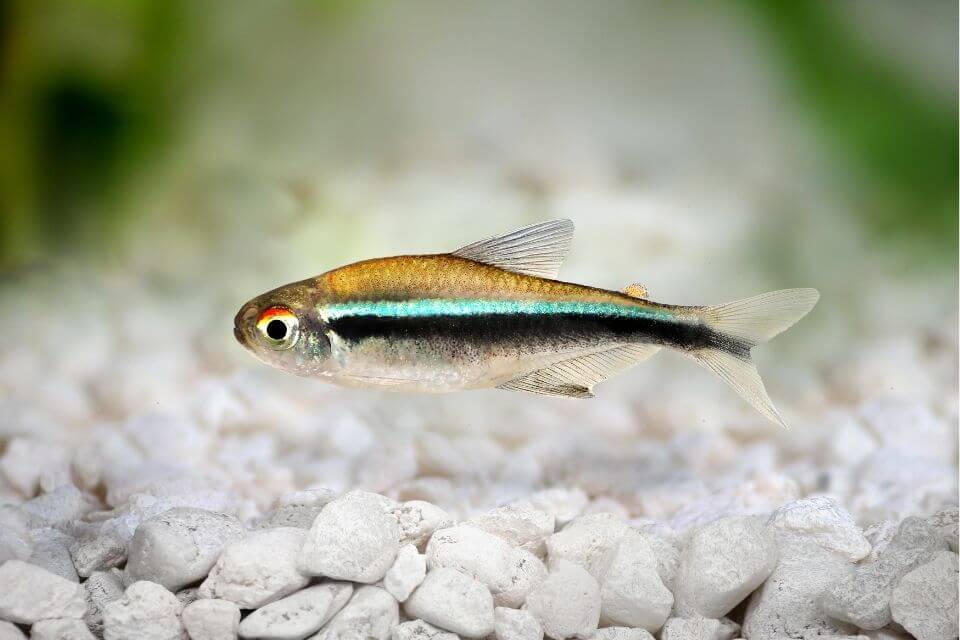
The Black Neon Tetra is considered a dazzling crown jewel of an aquarium. These freshwater fish species are pretty and relatively low in maintenance which makes them perfect for any aquarium.
However, since these fish are a variety of prevalent species, they get overlooked more often. But the Black Neon Tetra deserves more love.
As a newbie, these fish will best suit your needs as they are relatively easy to take care of, have a unique look, and tend to get along with almost all freshwater fishes.
In this Black Neon Tetra care guide, we shall be taking you through everything you will require to know about the Black Neon Tetra. By the time you are through this article, you will be ready to purchase and own one yourself. So, with that said, let’s get started.
| Quick Facts: | |
|---|---|
| Common Names : | Black Neon Tetra |
| Origin : | Paraguay River Basin in Brazil |
| Family : | Characidae |
| Scientific Name : | Hyphessobrycon herbertaxelrodi |
| Care Level : | Easy |
| Temperament : | Peaceful |
| Social : | Schooling fish |
| Diet : | Omnivores |
| Size (average) : | Up to 1.6 inches |
| Lifespan : | Up to 5 years |
| Breeding : | Egg layer |
| Minimum Tank Size: | 10 gallons |
| Tank Environment : | Freshwater , Sandy substrate, Lot of Plants, Rocks and caves |
| Temperature : | 68 - 82 °F (20 – 27 °C) |
| Water Hardness : | 4 - 8 dGH |
| Water pH Level : | 5.0 - 7.5 |
Species Overview
Irrespective of your experience as an aquarist, you have probably seen a traditional Neon Tetra at one point. Black Neon Tetra, scientifically known as the Hyphessobrycon herbertaxelrodi, is a similar fish species that take a darker appearance.
Often considered a darker cousin of Neon Tetra, the Black Neon Tetra are freshwater fish equally as beautiful and have low maintenance and care requirements. This Tetra species belongs to the Characidae family, and they are famous for their outstanding colors as well as energetic temperament.
They are famous among aquarists so much that approximately 2 million of them are sold in the United States per month. However, the vast majority of these fishes are bred in captivity.
What makes these fishes ideal for newbies is their non-aggressive temperament. Furthermore, they are beautiful, great, and excellent community fish that spend most of their time in the middle of water columns.
If you plan to have Black Neon Tetra, you will need to keep them in schools of at least 12 to 15 individuals. Fewer numbers than these will make them feel threatened and can lead to an increase in stress levels.
Origin and Distribution
These fishes are believed to have originated from Paraguay River Basin in Brazil. The natural habitat for these fish spans several hundreds of miles and is often found in floodplains, small tributaries, and rivers flowing through a dense forest.
Because of the stunning appearance of these fish species, they have bread commercially and distributed worldwide in the aquarium fish market. Most of the aquarium pet suppliers may carry Black Neon Tetra for sale.
If are looking to purchase these Tetra species we would recommend you to check with your local pet store or even online distributors.
Appearance and Colors
The Black Neon Tetra is undoubtedly beautiful and features a stunning appearance that will make your aquarium lively. This fish features two horizontal stripes across the body; one is black while the other is bluish-white in color.
Photograph by: Brian Gratwicke
The remaining parts of their body are light greyish brown in color except for the upper half of their eyes that incorporates an orange half-circle.
The Black Neon Tetra has a low, flattened elongated and lateral physique when it comes to appearance. The two stripes in this fish accommodate a pigment cell with high reflectivity. This is why it flashes in reflected light.
Black Neon Tetra Size
The average size of a fully grown Black Neon Tetra is approximately 1.5 inches in length. At times, these fishes are reported to reach 1.6 inches; however, this is very uncommon.
Due to their significantly small size, taking care of this Tetra species is relatively easy.
Black Neon Tetra Lifespan
The Black Neon Tetra has a lifespan that mimics regular Neon. These fish species have a lifespan of about five years. However, there is no guarantee that it will attain a 5 years lifespan while in captivity.
Although the Black Neon Tetra is famous for its hardiness, failure to offer them basic needs will dramatically reduce lifespan.
Therefore, if you want your fish to attain their potential lifespan, you will have to provide top-notch care by giving them a desirable environment and diet.
Black Neon Tetra Care
As stated earlier, taking care of a Black Neon Tetra is relatively easy; all required is to have the right tank conditions. Taking care of this fish species is no different from other species of the Tetra family.
The Black Neon Tetra tolerates an array of conditions which makes them easy to take care of. Additionally, they are easy to please, making it the best fish for any novice aquarist out there.
If you are on the lookout for a low-maintenance fish, you should consider the Black Neon Tetra. When provided with essentials, you will have no issue with keeping Black Neon Tetra.
Here are some of the vital aspects you will need to consider if you are planning on purchasing this Tetra species;
– Black Neon Tetra Tank Size
Since they are relatively small in size, you will not require a massive tank for your Black Neon Tetra. However, you should note that the tank size will depend on the number of fish you are planning on keeping.
The smallest tank size that you should consider at least 10 gallons that can accommodate a group of 6 individuals. But it is recommended to keep a minimum of 12 fish together to thrive well in a captivity environment.
Since they are schooling fish species and make them comfortable in your aquarium, Black Neon Tetra should be kept at a minimum of 12 to 15 individuals. Thus, the recommended size of your tank should be at least 20 gallons.
However, you can also go for a more spacious tank if you plan to have different species in a single tank. This is vital to note since Black Neon Tetras always love extra swimming space.
– Tank Setup
In addition to tank size, tank setup is a vital aspect that needs to be considered. Designing a rich tank is essential for keeping your Black Neon Tetras happy, healthy, and long life.
Try your best to recreate their natural environment as possible. By doing so, you will help them reduce stress while providing for them an enriched life. To achieve a decent tank environment for your Black Neon Tetra, you will need to start with a substrate.
For substrate, it is advisable to use sand at the bottom of the tank. Usually, these fishes venture at upper and mid waters and rarely at the bottom of a tank. However, having a sand substrate is similar to their natural habitat.
When it comes to decorations, you can use live aquarium plants. You can choose an array of plants and create thick vegetation in the background. While doing so, ensure to leave some swimming space for the fish at the center.

In addition to plants, you might consider adding rocks and driftwood. These natural décors will offer shelter from the tank’s light as well as the hiding places, and they will also act as an exploration place for your fish.
Although Black Neon Tetra does not release a ton of waste, their collective waste will have a major effect on the amount of nitrate and ammonia when kept in a group.
Therefore, a good filtration system is a must. Install a robust filtration system that can clean your tank efficiently. Ensure that the filtration process is powerful at the top of your aquarium.
When it comes to lighting, the Black Neon Tetra requires a light with an output of approximately 2 to 5 watts per gallon of water in an aquarium. Furthermore, you will have to keep your light on for about 12 to 14 hours per day, and you should avoid exposing them to light more than that.
– Water Parameters
In the wild, the type of water bodies that these fishes reside in are unique.
Usually, they are not crystal clear lakes or rivers; however, they are found in shallow streams full of decaying plant matter. Recreating the natural habitat of the Black Neon Tetra in an aquarium is relatively easy; you will need to stick to these water parameters;
- Water temperature should be between 68 and 82 °F (20 – 27 °C)
- The pH levels should be between 5.0 – 7.5
- Water hardness has to be around 4 – 8 dGH
You will need to assess your aquarium water more often when introducing these fishes for the first time in your tank. During the transitional phase, the Black Neon Tetra are more likely to develop health problems due to changes in water parameters.
– Suitable Aquarium Plants
You will need plants to recreate the natural habitat for these fishes in an aquarium. Some of the suitable aquarium plants include;
– Common Diseases and Prevention
Black Neon Tetra are hardy fish species; however, they are not immune to infections. These fishes are predisposed to the same diseases as other tropical fish, including common health concerns such as Dropsy and Ich.
Fortunately, treating these diseases is relatively easy. In fact, Black Neon Tetra is known to respond well to over-the-counter drugs. However, the best way of handling disease is to avoid it altogether.
Therefore, to protect your Black Neon Tetra against common diseases, you will need to maintain good tank condition as well as keep an eye on the water parameters. Once the water parameters go south, your fish will fall ill.
You will need to replace approximately 30 to 50% of your aquarium water each week to keep it in great shape. One vital aspect to keep in mind when it comes to these fishes is that they can quickly carry infections into your tank.
They are well-known to fall ill to a disease known as Neon Tetra Disease. This is a parasitic infection that affects the Tetras.
A fish will become infected with this parasite from an infected fish, and they will spread the parasite throughout the tank affecting the whole community. As of the writing of this article, there is no known cure for this parasite.
Therefore, you need to ensure that you are getting healthy fish and from a reputable source.
Diet and Feeding Requirements
The Black Neon Tetra are omnivores. In their natural habitat, these fish feed on algae, small crustaceans, and plant detritus. In captivity, you can still feed your Black Neon Tetra an array of foods.
A well-balanced diet will be best for your fish; this will ensure that it gets all the required nutrients, improving its appearance and coloration.
For starters, you should feed your Black Neon Tetra pellets or dry flakes. You might supplement this with bloodworms, brine shrimp, mosquito larvae, daphnia, along with other protein-dense foods.
When feeding your fish, ensure that you do not overfeed them. Not only will it lead to health complications but also negatively impact water quality in your tank.
Gender Differences
Due to their small sizes, sexual differences are not apparent in these fishes. However, female Black Neon Tetras have more prominent and more rounded bellies as opposed to the male tetras.
When sexually mature, a female Black Neon Tetra’s stomach is filled with eggs. If a Black Neon Tetra is not sexually matured, identifying males from females is challenging and almost impossible.
Black Neon Tetra Breeding
In most cases, Black Neon Tetras are bred in captivity. Usually, spawning occurs naturally in a community tank. However, it is recommended that you set up a different breeding tank for the fish fry to survive.
You will require a 10 gallons tank as the breeding tank. In this tank, you will need to add lots of plants, the dark sand substrate as well as subdued lighting. You will also need to introduce a bonded pair. Condition your pair with live food.
Photograph by: Vash Stampede
Raise your tank’s temperature slowly to around 80 degrees Fahrenheit over a period of several days. These temperature levels will trigger spawning. And a pregnant Black Neon Tetra will lay hundreds of eggs at a time.
The eggs can be scattered in a substrate or stuck on the underside of leaves. These eggs will then hatch after 22 hours.
You will need to remove adults before the eggs are hatched since these fishes do not have parental instincts. Wait for three to four days before feeding the fish after they are hatched, and then start by giving them infusoria or brine shrimp.
Let them remain in a separate tank with the adults until they are fully grown.
Behavior and Temperament
As a newbie aquarist, you will fall in love with the Black Neon Tetra. These fishes are gentle and passive, and they do not exhibit any aggressive behavior.
Even when kept in groups, male Black Neon Tetras are not territorial, which is a behavior that is common with other fish species.
It is relatively easy to point out that the Black Neon Tetra are schooling fishes. During the day, these fish will explore the aquarium together. Furthermore, they often swim in unison and create a beautiful swathe of dark colors around your aquarium.
Although these fish prefer swimming and staying in schools, they are not fully dependent on one another. The school can break up once in a while, allowing each fish to hide and relax.
Black Neon Tetra Tank Mates
Due to their relatively small size, the Black Neon Tetras have to be kept with other small fishes that will not have them for lunch. You will need to avoid aggressive or large fish and keep your tank peaceful to prevent accidents or injuries.
Their best tank mate will be another Black Neon Tetra. Additionally, other potential tank mates for these fish are;
- Pearl Gourami
- Neon Tetras, including the Green Neon Tetras
- Chili Rasbora
- Celestial Pearl Danio
- Honey Gourami
- Small Freshwater Catfish
- Freshwater Aquarium Snails
- Sparkling Gourami
- Rummy Nose Tetra
- Harlequin Rasbora
How Many Black Neon Tetras Are in A School?
It is recommended to keep Black Neon Tetras in a school of 12 to 15 and a minimum of 6. Since they are schooling fishes, Black Neon Tetras must be kept in a school to prevent the fish from becoming stressed.
As we mentioned earlier they so more comfortable when living in groups and reduce health issues.
Are Black Neon Tetras Aggressive?
No, Black Neon Tetras are not aggressive. They are known to get along with other fish making it easy to find suitable tank mates.
Because of the peaceful nature, you much keep them with the tank mates that have similar behaviors that make them more comfortable.
Are Black Neon Tetras Fin Nippers?
Due to their non-aggressive nature, Black Neon Tetras are not fin nippers.
However, when stressed or during breeding, all fishes tend to be aggressive when they feel threatened and will lead to them nipping other fish’s fin. Usually, this is a defensive mechanism, and all fishes, including Black Neon Tetras, tend to have it.
Are Black Neon Tetras Hardy?
Yes, Black Neon Tetras are considered hardy fish, making it ideal for newbie aquarists out there. These fish tend to adapt well to various tank conditions. They are also relatively easy to feed.
Do Black Neon Tetras Jump?
Usually, Neon Tetras are good at jumping, and the Black Neon Tetras are no different. However, they are more persuaded to jump out of a stressful or crowded place.
Providing them ample space might help to prevent escape from their space. Also do not forget to cover your tank top with a weighted lid for a stressful mind.
Where Black Neon Tetra for Sale?
Since they are bred in captivity, you can easily find Black Neon Tetra for sale in a fish shop next to you. Even online eCommerce sites will carry Black Neon Tetra for sale at affordable prices.
What Is Black Neon Tetra Price?
The Black Neon Tetra tends to be relatively affordable, going for about $2 to $3 per fish in the USA. In the other regions, the prices may vary based on availability.
Closing Thoughts
Taking care of Black Neon Tetras is as easy as it gets. These fishes are relatively easy to take care of and can be owned by experienced and novice aquarists.
After going through this article, you can comfortably own these fish species, and we hope you consider giving them a shot. As we conclude, we hope you have found this article beneficial.




